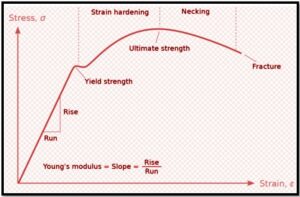Table of Contents
The Young modulus, also known as the elastic modulus in tension or compression, is a mechanical parameter that determines a solid material’s tensile or compressive stiffness when a force is applied longitudinally.
A Brief Outline
In the linear elastic region of a material, it measures the relationship between tensile/compressive stress σ (force per unit area) and axial strain (€) (proportional deformation). Young’s moduli are usually so big that they are measured in gigapascals rather than pascals (GPA).
Important Concepts
At the point when a particular load is applied to a strong item, it disfigures. Whenever the strain is taken out from a versatile item, the body gets back to its past shape. Past a little level of bending, numerous materials are not direct and versatile. Just direct versatile material has a consistent Young’s modulus.
Young’s Modulus Formula
E = σ/€
Young’s Modulus Formula from Other Quantities
E = σ/€ = (F/A)/(∆L/L0)
Notations Used in The Young’s Modulus Formula
E = young’s modulus in Pa
? = uniaxial stress in Pa
ε = strain or proportional deformation
F = force exerted by the object under tension
A = actual cross-sectional area
ΔL = change in the length
L0 = actual length
The bulk modulus (K) is a three-dimensional version of Young’s modulus. It’s a volumetric elasticity metric that’s calculated by dividing volumetric stress by volumetric strain. When opposing forces apply on an item, the shear or modulus of rigidity (G) describes the shear. It’s computed by multiplying shear stress by shear strain. The Young’s modulus of a material is frequently affected by its orientation. Isotropic materials have the same mechanical characteristics in all directions.
Young’s modulus is immediately applicable to cases of uniaxial stress, which is defined as tensile or compressive stress on one side with no stress on the other. Young’s modulus is also used to forecast the deflection that will occur when a load is put between the beam’s supports in a statically determinate beam.

Significance of dimensions of young modulus in IIT JEE exam
The topic of solid and liquid properties receives a 5% weighting. Some of the major topics for this JEE exam include elastic behaviour, stress-strain relationships, Hooke’s Law, Young’s modulus, bulk modulus, and modulus of rigidity. In this chapter, you will be asked 4 to 5 questions.






